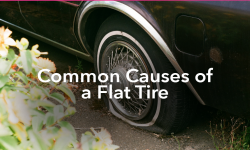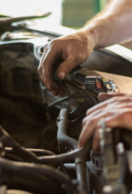Although it is often referred to as "tire alignment" or "wheel alignment," the alignment of your car actually isn't directly related to your tires or wheels. Adjustments to your alignment are actually adjustments to the suspension of your whole vehicle--which certainly does affect your tires, wheels, and your car's driveability.
So how do you know whether your car's alignment needs to be adjusted?
Signs Your Car Needs an Alignment
Here are a few telltale signs that your car is out of alignment:
- Pulling. If your car seems to drift toward the left or toward the right when you loosen your hands on the steering wheel, this is a sign that your alignment is off. If your tires are even slightly angled in one direction or another, your car will naturally pull in that direction, making it a bit harder for you to steer as you have to compensate for the car's pull. This is not an efficient way to drive and can cause problems for your tires.
- Off-center steering wheel. If you're headed straight down the road, but your steering wheel is tilted at an angle, that's another sign that your alignment is off.
- Vibrating steering wheel. If your tires aren't pointed straight ahead, parallel with one another and with the vehicle as a whole, you may experience vibrations in the steering column as a result.
 Uneven tire tread wear. This is one of the most salient problems with misaligned vehicles, as it can force drivers to replace tires more frequently. It's normal for tires to wear down over time. However, when they start to wear in uneven patterns, differently on one side than the other, or forming sharp edges, the car probably needs to be aligned.
Uneven tire tread wear. This is one of the most salient problems with misaligned vehicles, as it can force drivers to replace tires more frequently. It's normal for tires to wear down over time. However, when they start to wear in uneven patterns, differently on one side than the other, or forming sharp edges, the car probably needs to be aligned.
Automotive professionals fix your alignment by adjusting the angles of the tires as they make contact with the road. The primary angles involved are called camber, caster, and toe--referring to the inward or outward tilt of the tires, as viewed from the front of the car (camber), the tilt of the steering axis of the wheels (caster), and the direction the tires point as viewed from above--whether toward or away from the midline of the car (toe).
When to Get an Alignment
It's standard procedure to have your vehicle's alignment adjusted whenever you get new tires, to ensure that they wear evenly. It's also a good idea to have it checked and needed adjustments made annually, whether or not you're experiencing any of the above symptoms.
If you think it's time to get an alignment adjustment done on your vehicle, take it in to All in the Wrist Auto for all the maintenance services you need. Your tires will thank you!






